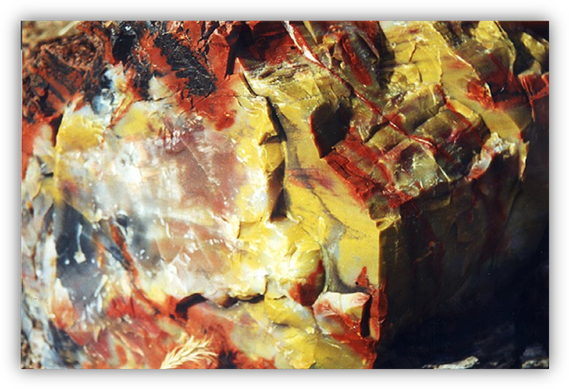![j0198530[1]](SCI180_U31_The_Fossil_Record_image003.png)
THE
FOSSIL RECORD
Unit Overview
There is plenty of scientific
evidence to support the theory of evolution. Because of this evidence,
scientists have developed different theories on evolution. The last unit
introduced the theories of Darwin and Lamarck. This unit will introduce fossils
and their formation, a historical timeline of fossils, and how the fossil
record indicates that a great number of species developed and changed through a
gradual process over time.
|
GLOSSARY
OF KEY TERMS |
|||
|
fossil
record |
evolution |
paleontology |
petrified
forest |
|
trace |
trilobite |
cast |
mold |
|
imprint |
coprolites |
radioactive
dating |
half-life |
|
carbon
dating |
molecular
dating |
law of
superposition |
James Hutton |
|
index
fossil |
absolute
age |
|
|
The Fossil Record
A fossil record is like a jigsaw puzzle that is billions of years old. More than half of all the pieces are missing. Some of the pieces are discovered, one or two at a time. A fossil record is evidence that gives us a partial picture of life on Earth. The record shows us the process of extinction, which is normal throughout Earth’s history. So we could say that a fossil record can span billions of years and includes everything from bacteria and algae to early humans. So far the fossil record has given us a partial picture of life on Earth. All of the evidence that scientists have collected forms what is known today as the fossil record. This is the most complete biological record of life on Earth. So what will we find out about Earth’s history? We will discuss the fossil record more in depth later in the unit.
Changes over Time
We
have discussed how organisms changed over time and how many of those organisms
were related to each other. These changes over time were defined as evolution. So in other words we could
say that evolution is a change in a species over time. We already know that a
species is a group of organisms with similar characteristics that can
interbreed with each other to produce offspring. During the course of this unit
the following questions will be asked:
|
How do living things change? |
|
Why do some organisms survive and other die off? |
|
How can we trace the evolution of living things? |
|
What type of evidence supports the theory of
evolution? |
We have learned that many
organisms survived and reproduced while others died out. Because of this
process, many of the living things from millions of years ago no longer exist.
Fossils Determine Change
Paleontology
is the study of ancient (prehistoric) plant and animal life. Clues to Earth’s
past environment, climate, and living organisms are based on the preserved
remains of plants and animals, or fossils. Fossils are buried deep in the Earth
and the great majority of animals and plants decay before becoming fossilized.
Only a fraction of fossil finds represent all of the billions of organisms that
have lived on Earth. A fossil is an imprint
or remains of plants and animals that existed in the past.
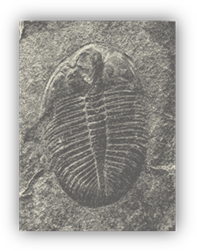 Only a
handful of fossils ever find their way to the Earth’s surface. Many of them
turn to dust before humans ever find them. Many people believe that dinosaurs
are the celebrities of the fossil world. However, the age of dinosaurs is just
a small portion of organisms found in the fossil record. Keep in mind that a
fossil record includes all of the known fossils, not just dinosaurs. The fossil
record spans billions of years and includes everything from bacteria and algae
to early humans.
Only a
handful of fossils ever find their way to the Earth’s surface. Many of them
turn to dust before humans ever find them. Many people believe that dinosaurs
are the celebrities of the fossil world. However, the age of dinosaurs is just
a small portion of organisms found in the fossil record. Keep in mind that a
fossil record includes all of the known fossils, not just dinosaurs. The fossil
record spans billions of years and includes everything from bacteria and algae
to early humans.
Plants and animals have two
very slim chances of becoming a fossil when they die. Of course it all depends
on biology. Plants or animals with many hard parts (teeth, bones, shell, and wood)
have a greater chance of becoming fossilized than those with soft parts (flesh,
leaves, stems). A plant or animal can also become fossilized if they are buried
in a substance that can preserve it such as tar or ice. Sediment from rivers
can also preserve specimens.
Past Extinctions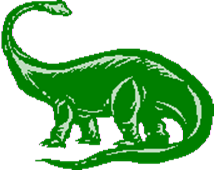
Over the last 600 million
years on Earth, numerous extinctions have taken place. These extinctions have
included both plants and animal species. Records of these fossils have been
found in the rock layers. These fossilized remains have revealed at least six
major extinctions over many millions of years. There was a major extinction
that occurred around 250 million years ago. This happened during the Permian
period when about 96% of the marine species died. This particular extinction
has exceeded all other known die-offs. Probably the most famous extinction
occurred when the dinosaurs died off, along with about 50% of all other
species. This happened about 65 million years ago.
Today, many scientists
believe that the major extinctions may have been caused by a large space object
or objects hitting the Earth. They believe that these objects caused dust and
debris to enter the atmosphere, blocking out the sun and causing climate
changes that disrupted the food chain. In recent years, scientists have made
another discovery that they believe is significant. They have focused their
attention on an area near the Yucatan Peninsula. In 1992 they found a huge
crater impact that was formed approximately 65 million years ago. This discovery
may have been the cause of the dinosaur extinction and their plant and animal
contemporaries. However, with this discovery, no evidence has turned up that
will explain the extinction 250 million years ago.
Fossil Formation
Scientific evidence has
suggested that many kinds of organisms have existed upon the Earth for at least
3.5 billion years. How do we know this? The remains or evidence of those
organisms have been preserved in layers of rock and are called fossils. The
term fossil means “something dug up.” As was mentioned earlier in the text, it
is quite unusual to find a completely preserved organism. Many of these fossils
form in sedimentary rock. The hard parts of organisms are often replaced by
mineralization. The hard parts of the plants and animals become trapped as the
sediments harden into rock. Other kinds of fossils form when both the hard
parts and soft parts of living things become buried in layers of ice or trapped
in tree sap that later hardens. Other types of fossils include molds, casts, or
imprints of an animal or plant. Sometimes trace
fossils are found, an example being a footprint. The chance of an organism
leaving fossil evidence on the Earth depended on natural conditions. Many
plants and animals decayed naturally before they could ever turn into a fossil.
There are many different
kinds of fossils. A petrified fossil forms when minerals replace the bone,
shell, or other hard part of the organism that was trapped, turning it into
rock. The illustration below is an example of petrified wood. Petrified wood is
tissue from ancient trees that has been replaced by minerals, converting it
into stone. The wood is turned into quartz crystal which is very brittle and
fragile, yet is also harder than steel. In some cases the cell structure is so
perfectly preserved that it resembles microscopic stem sections of modern
plants.
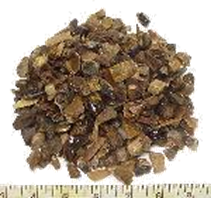
In Arizona, there are some
wonderful examples of petrified wood. The trees of this Petrified Forest have been preserved for more than 200,000 years.
The remains of the trees, the fossil logs, show almost every detail of the
once-living forest. Even the patterns of the growth rings are visible.
Petrified Wood
You can read more about the Petrified
Forest at the following web site: http://www.americansouthwest.net/arizona/petrified_forest/national_park.html and/or to view the Home Page click on the PDF File.
To view a map of the
Petrified Forest National Park click on the PDF File.
Trace
fossils include footprints, tracks, trails, and burrows made by living things. There
are trace ancestors of human ancestors who walked on two feet. Trace fossils
have been left behind by animals such as worms, which were too soft to be
preserved. The following illustration shows a trail made by a trilobite. It shows the
central paired leg grooves and the furrows on the outside edge.
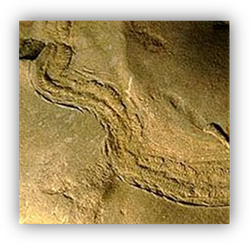
TRILOBITE TRIVIA: Ohio’s state fossil is the trilobite.
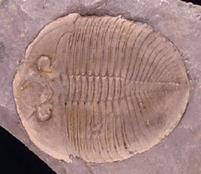
 Among famous groups of extinct organisms, trilobites
probably rank second only to the dinosaurs in fame. Their fossils are instantly
recognizable and often strikingly beautiful. In fact, prehistoric people liked
them as much as we do. At Arcy-sur-Cure in France, a
15,000-year- old human settlement, one of the artifacts found by archeologists
was a trilobite that had been drilled to be worn as an amulet.
Among famous groups of extinct organisms, trilobites
probably rank second only to the dinosaurs in fame. Their fossils are instantly
recognizable and often strikingly beautiful. In fact, prehistoric people liked
them as much as we do. At Arcy-sur-Cure in France, a
15,000-year- old human settlement, one of the artifacts found by archeologists
was a trilobite that had been drilled to be worn as an amulet.
Although the last few trilobites went extinct about
245 million years ago, they are one of the best-known and most-studied groups
of fossil arthropods.
Another method of preserving
is by freezing. Freezing helps to preserve the substances. Wooly mammoths have
been found, frozen for some 10,000 years. Furry rhinoceros’ have been found
preserved in loose frozen soil in the arctic.
Amber is another effective
way of preserving organisms. Resin (sap) from certain evergreen trees hardens
and contains trapped insects. The resin usually perfectly preserves the
insects. On occasion DNA has been extracted and sequenced from these amber
preservatives. Amber is sometimes referred to as nature’s transparent tomb.
Tar pits are large pools of
tar and contain the fossil remains of many species of animals. Water often
covered these tar pits. When the animals went there to drink, they were trapped
in the tar. Eventually the animals sank to the bottom of the pits. The
following animal species have been found in tar pits around the world and have
been perfectly preserved: bison, camel, giant round sloth, wolves, vultures,
saber-toothed tigers and the furry rhinoceros. Many of these animals lived over
a million years ago.
A cast is a model of the shape of a living thing or its remains. A
cast forms when minerals or rock particles fill the space in a mold. Sometimes
the mold is filled in by minerals in the sediment. The minerals harden to form
a cast, or filled-in mold. A cast is in the same shape as the original
organism. A mold is a space in a
rock that has the shape of the remains of a living thing that once occupied
that space. If the soft parts of an organism are dissolved by chemicals, an
empty space will be left in the rock. The empty space, called a mold, has the
same shape as the organism. The following illustration is an example of a mold
from a Prosauropod dinosaur.
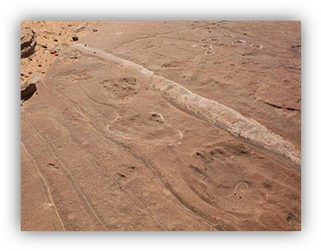
An imprint is an impression of part of an organism left in soil, mud,
or sediment before it hardens. Objects such as leaves, fish, and feathers form
imprints.
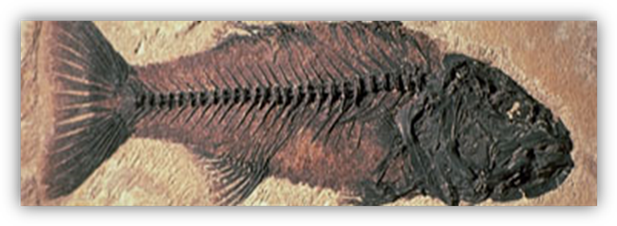
Coprolites
are petrified remains of animal dung, or manure. Coprolites reveal what an
animal ate. This shows what other living things shared the animal’s
environment.
The Dating Game
Scientists use methods to
measure the age of fossils and rocks where fossils are found. This is called radioactive dating. This process
involves the use or radioactive elements. A radioactive element is one whose
atoms give off radiation as it decays, or breaks down, into the atoms of a
different element. We will discuss what radioactive dating has to do with the
evolution of plants and animals.
In a few seconds some
radioactive elements will decay. Others will take up to billions of years to
decay. However, the decay rate for each element is steady. Scientists measure
the decay rate of a radioactive element by a unit called a half-life. The half-life of an element is the time it takes for
half of the radioactive element to decay. Depending on the actual age of rocks,
several different radioactive elements are used for dating.
Another method of dating is carbon dating. In this process
radioactive carbon is used to date organic remains such as wood and bones. When
an organism dies, carbon ceases to enter the organism and the carbon already
present begins to decay. The amount of carbon that remains allows scientists to
determine the age of the organism’s remains. The carbon dating and radioactive
dating processes are much more complex than is introduced here, but this is a
brief description of the processes.
The concept of molecular dating is a rather new
innovation. It is an attempt to understand the theory of evolutionary. The idea
of this theory is that the accumulation of mutations is considered to happen at
a somewhat steady rate. You should recall from the last unit that the amount of
variation between two different species depends on how long ago their
evolutionary paths diverged from a common ancestor. The more the variation
between the two sequences, the more distantly related the species are. By
calculating estimates of the mutation rate, it is possible to calculate when
the two species diverged. The idea of molecular dating is quite simple;
however, the rate of error is not. The biggest problem with this type of dating
is that mutation rates are not constant for all species over great periods of
time. There have been numerous attempts to apply molecular dating techniques to
estimate the time of origin of a particular species, however, this poses a
significant challenge.
Even though molecular dating
is quite young, being developed in the last decade, there are many sources of
error. While the idea is simple, it is often not in reality. In order for molecular
dating to become a much more reliable concept, mutation rate changes will have
to be determined. Who knows what the future may hold? Molecular dating may
become a useful tool in evaluating the fossil record.
Every few years, scientists
publish new geologic time scales that provide the latest dates for major time
lines. Older dates may change by a few million years up and down, but younger
dates are stable. The way we understand the shape and pattern of the history of
life depends on the accuracy of fossils and the dating methods. Critics
question certain aspects of the quality of the fossil record and of its dating.
These skeptics don’t necessarily provide scientific evidence for their
particular views. The current understanding of the history of life is probably
close to the truth because it is based on repeated and careful testing and
consideration of data. However, keep in mind that not everyone agrees with the
theory of evolution or the methods used for testing it.
Fossil Interpretation
Fossils can help scientists
learn much about the history of the Earth. Fossils indicate that many different
forms of life have existed at different times throughout the history of the
Earth. Some scientists think that for every type of organism alive today, there
are about 100 types of organisms that are now extinct.
When fossils are arranged in
an order according to age, they are able to show how living things evolved and
changed over time. Scientists can determine how a living thing has evolved over
millions of years by examining the changes in fossils. The fossils themselves
show how the surface of the Earth has evolved. If scientists found fossils of
sea organisms in rocks high above sea level, they can assume that the land was
once covered by an ocean. In Ohio, a similar kind of event happened. On the
western edge of the state, there is a state park called Hueston
Woods. In the park there is much evidence of a shallow sea that once covered
the state. Fossilized sea organisms, such as trilobites, are abundantly found
in this area. This tells us that at one time this area was covered by an ocean.
Because of this event, the trilobite became the state fossil.
Scientists have also used
fossil evidence to determine the past climate on Earth. The fossils also indicate
what extinct animals looked like and how they behaved. From fossils of bones,
teeth, and footprints, scientist can build models of these extinct animals.
They are able to determine size and weight, and how fast an animal could move.
Fossilized teeth provide clues about the kind of food an animal ate.
The Sequence of
Fossils
We already know that fossils
occurred in sequences. This fact was established long before Charles Darwin had
even thought of evolution. As early as the 1700’s, geologists noticed that
fossils seemed to occur in sequences. This first work was done in England and
France.
Around the year 1800, William
Smith from England noticed that he was able to map out great tracts of rocks
based on their contained fossils. He realized that the sequences he saw in one
part of the country could be correlated (matched) precisely with the sequence
in another. He, along with others of his time, had discovered the first
principles of stratigraphy. This discovery demonstrated that older rocks lie below
younger rocks, and that fossils occurred in a particular, predictable order.
Shortly after this time, geologists developed the stratigraphic column which
listed the familiar listings of divisions of geologic time. After the 1830’s,
geologists began to notice how fossils became more complex through time. The
oldest rocks contained no fossils, and then came simple sea creatures, then
more complex ones like fishes, then came life on land, then reptiles, then
mammals, and finally humans. It became very clear that there was some kind of
progression evolving. After Charles Darwin published his book “On the Origin of
Species” in 1859, the progression shown by the fossils documented the pattern
of evolution through long periods of time.
A History of Fossils
Scientists are able to use
the evidence found in rocks and fossils to determine the order of events that
occurred in the past. They are able to tell what happened first second, third,
and so on. They are also able to approximately determine the time at which
events happened. So in other words, scientists are able to write a history of
fossils and the Earth.
As was mentioned earlier in
the unit, sedimentary rocks are where most fossils are found. These rocks are
made up of layers of sediments, one piled on top of another. If the rocks are
not touched, obviously the oldest rocks are on the bottom. The sedimentary
layers are stacked in order according to their age. The law of superposition says that in a series of sedimentary rock
layers, the younger rocks are normally on top of the much older rocks. The word
superposition means that one thing is placed on top of another.
The law of superposition is
based on the premise that sediments have been deposited throughout Earth’s
history in much the same way. A scientist named James Hutton came up with the theory that the processes acting on
Earth today are the same ones that acted on the Earth millions of years ago.
These processes included weathering, erosion, and deposition. You should recall
that weathering is when rocks break down into sediments. The carrying away of
sediments is known as erosion and deposition is the depositing, or laying down,
of sediments.
Scientists use the law of
superposition in order to determine if a fossil or layer of rock is older or
younger than another fossil or layer of rock. Remember that the sediments on
the bottom are older. Sedimentation is still occurring today. Even as you are
reading this text, fossils are being trapped at the bottoms of lakes, rivers, and
the oceans. Scientists use the law of superposition to help them order the
record of Earth’s past. Scientists use the knowledge they have acquired about
rock layers to determine the age of fossils. Even though rock layers are in
different parts of the world, scientists are able to determine the age of the
fossils by the rock layers that are close in age. They use an index fossil to accomplish this task.
They use the fossil of an organism that existed on Earth for only a short
period of time and that can be used by scientists to determine the relative age
of a rock.
|
FOSSIL TRIVIA |
|
|
|
Millions of fossils have
been discovered. |
|
Fossil hunting began by
accident in England around 1800. |
|
Stratigraphy, the study of rock
layers, led to paleontology, the study of fossils. |
|
Fossils prove that humans
did not exist alongside dinosaurs. |
|
Scientists now use
phylogeny, mathematics, and other computations to date fossils. |
|
There is only a 1% chance
of error with current dating methods. |
A Timeline
By the end of the 1800’s,
scientists had determined a clear picture on what had taken place in Earth’s
history. This picture showed many varied changes. Scientists also knew the order
in which the changes had happened. What they didn’t know was how many years had
evolved between these changes. They knew that the changes had taken millions of
years, but they wondered if a clock made of rock layers measures these lengths
of time.
So the scientists set to work
to determine a timeline. They knew that at first they had to figure out the
rate at which sedimentary rock was deposited. The scientists assumed that
sediment was deposited at a steady rate during Earth’s past and also at the same
rate it is deposited today. They determined the depth of deposition per century
first. Then the total amount of depositing was measured and divided by the
yearly rate, the age of the oldest sedimentary rock could be calculated. This
method was used as well to determine the age of the fossils found within. These
calculations used to determine a timeline are more complex than what is
presented here; however, it gives you an idea of the process.
What scientists came to find
out is that there is not a steady rate of depositing sediments. Even though
this method was not an effective way of calculating the age of the rocks, it
marked the beginning of efforts to measure the absolute age of events on Earth.
Absolute age gives the precise time
an event occurred, not just the order of events that relative age provides. By
the early 1900’s, scientists agreed that the Earth was at least several hundred
million years old. Today we know the Earth to be about 4.6 billion years old.
What do we know?
The fossil record indicates a
long history of extensive change in life forms. There is an enormous amount of
evidence which supports evolution. We know that living things on the Earth were
very different in the past, and as time led to the present, the kinds of
animals and plants on Earth changed, or evolved, into those we see today. There
are quite a number of fossils which show a consistent picture of change and an
orderly succession up to the present time.
The most extensive life for
changes occurred during major episodes of extinction, where in relatively short
periods of time, entire species of plants and animals vanished, only to be
replaced by a new set. So when large groups of organisms died due to a global
crisis, their disappearance made way for the expansion of new species of plants
and animals.
We know from the last unit,
according to Charles Darwin, that only those organisms best suited to their
environment survived and passed on those traits to the next generation. We also
know that in biological evolution, species evolved over time and evolution was
the consequence of the interactions from the following:
·
the potential for
a species to increase its numbers
·
the genetic
variability of offspring due to the mutation and recombination of genes
·
an ample supply
of the resources required for life
·
natural
selection, or the survival and reproduction of those organisms best adapted to
their surroundings
Natural selection and its
evolutionary consequences provide a scientific explanation for the fossil record
of ancient life forms.
We know that the fossil
record proves the progression of life from simple beginnings to complex
organisms: animals without backbones predate vertebrates, amphibians appear
after fish, and mammals occur after reptiles. There is a vast body of fossil
evidence of evolution and of natural selection. We know that fossils can help
to define the ancestral character states and help explain relationships between
extinct organisms.
Unit Extensions
Recommended reading:
·
Dinosaur and
Other Prehistoric Animal Factfinder by Kingfisher Books, 1998.
Topics to explore:
·
Fossil Butte
·
James Hutton
Careers to explore:
·
museum technician
·
museum curator
·
paleontologist
·
geologist
·
paleontological
illustrator
Unit Conclusion
Evolution is based on
authentic evidence of how life on Earth works. In order to understand fossils
and the diversity of species, it is useful to learn how they formed. Millions
of fossils, found in well-dated sequences of rocks, show evolution of organisms
through time and show numerous transitions among species. The fossil record
represents the progression of life from simple beginnings to complex organisms.
By understanding the fossil record, we can appreciate the unfolding of life
from Earth’s past and the certainty of continuous change in future generations.
